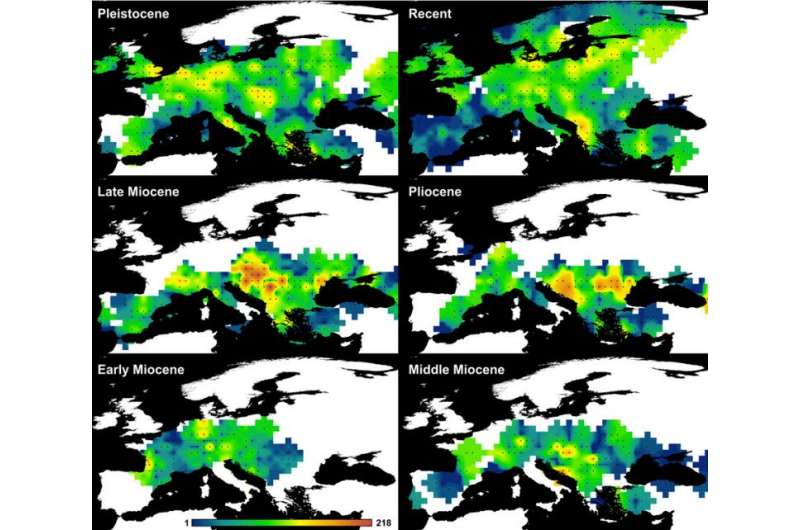September 1, 2015 weblog
Analysis finds species diversity driven by tectonics and climate

(Phys.org)—Biology often uses the word "hotspot" to characterize a region that gives rise to an abundance of species over a particular time period. A new paper in the Proceedings of the National Academy of Sciences suggests that the development of continental aquatic species hotspots is tightly linked to the climatic and geodynamic history of the European continent.
The researchers, from the Natural History Museum of Vienna, offer examples of such geodynamics-driven evolution as the development of the Indian monsoon, which was triggered by the collision of the Indian subcontinent with Eurasia causing the uplift of the Himalayas. This paleogeographic-climatic event over 20 million years ago now profoundly affects half of the world's population.
The paper regards hotspots as areas of species richness and their evolution over geologic time. The initiation and demise of continental basins leads to the development and persistence of freshwater and brackish environments, and strongly influences the dispersal, radiation and evolution of marine and nonmarine life. The paper attempts to track the geologic, climatic and physiographic parameters through an examination and regression analysis of marine species diversity in the fossil record.
- Early Miocene: Around 21 million years ago, there were only three known, fairly small hotspots of species richness. The authors find an increase in diversity that coincides with the rising temperatures after the comparatively cool Oligocene.
- Middle Miocene: During this period, species richness in Europe increased to a maximum—this occurred at what climatologists refer to as the Middle Miocene Climate Optimum. The changes in speciation were driven by the rise and dissipation of freshwater lake basins; although most declined, a new hotspot on the Balkan Peninsula resulted from the folding of the Dinaride Mountains, accommodating new lakes and species. After the decline, species richness rebounded about 5 million years ago.
- Late Miocene: All previous European hotspots disappeared, and a very large new one emerged in the Pannonian Basin. A peak in diversity was followed by another major Miocene turnover, with a rise in rates of extinction.
- Pliocene: The total number of species reached a temporary maximum; this is followed by the extinction of more than 300 species that corresponded with a mid-Pliocene warm period.
- Pleistocene: Global and regional cooling during this period resulted in a decline in species richness. A number of major long-lived lakes declined, along with the maximum number of species per lake.
- Recent: The Ice Ages brought glaciation of much of Northern Europe and the Alpine region, and many major lakes and their faunas vanished. Most of the existing lakes emerged after the Last Glacial Maximum, along with their faunas.
The researchers demonstrate that the shifts of species richness hotspots throughout time are linked to the development of geologic basins that accommodate long-lived freshwater and brackish environments. They write that "the availability of a persisting, stable geologic basin providing continual freshwater or brackish environments is a prerequisite for hotspot evolution for aquatic gastropods... The rise and demise of species richness hotspots throughout time is tightly related to regional and tectonic phases."
More information: "Tectonics, climate, and the rise and demise of continental aquatic species richness hotspots." PNAS 2015 ; published ahead of print August 24, 2015, DOI: 10.1073/pnas.1503992112
Abstract
Continental aquatic species richness hotspots are unevenly distributed across the planet. In present-day Europe, only two centers of biodiversity exist (Lake Ohrid on the Balkans and the Caspian Sea). During the Neogene, a wide variety of hotspots developed in a series of long-lived lakes. The mechanisms underlying the presence of richness hotspots in different geological periods have not been properly examined thus far. Based on Miocene to Recent gastropod distributions, we show that the existence and evolution of such hotspots in inland-water systems are tightly linked to the geodynamic history of the European continent. Both past and present hotspots are related to the formation and persistence of long-lived lake systems in geological basins or to isolation of existing inland basins and embayments from the marine realm. The faunal evolution within hotspots highly depends on warm climates and surface area. During the Quaternary icehouse climate and extensive glaciations, limnic biodiversity sustained a severe decline across the continent and most former hotspots disappeared. The Recent gastropod distribution is mainly a geologically young pattern formed after the Last Glacial Maximum (19 ky) and subsequent formation of postglacial lakes. The major hotspots today are related to long-lived lakes in preglacially formed, permanently subsiding geological basins.
Journal information: Proceedings of the National Academy of Sciences
© 2015 Phys.org



















